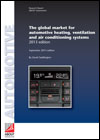|
But perhaps the most significant factor impacting the HVAC market in recent years has been the European Union (EU) legislation banning the refrigerant R134a used in automotive HVAC systems. While the same legislative pressure is not taking place in North America and Japan, these markets are following the lead and moving to replace R134a as well.
And although it looked as if vehicle manufacturers had finally reached consensus over a new replacement refrigerant, recent concerns over safety have once again created uncertainty - seemingly putting HVAC suppliers back in the position of having to develop equipment for two different systems.
Brand new research on the automotive HVAC sector
This report highlights the findings of research conducted throughout 2013 by ABOUT Automotive in the automotive air conditioning market. It is largely based on our research, analysis and interviews with a number of industry experts, gathering individual perspectives.
ABOUT Automotive has been tracking the automotive HVAC sector since 2002, and this research, now in its 5th edition, updates and extends our previous analysis of this sector, providing valuable insights in a number of areas, including:
- The market for automotive climate control, determining the trends and topical issues;
- The main manufacturers serving this sector, identifying how the market is divided in terms of market share and market value on a regional basis;
- Trends in key product and process technologies, both current and future; and
- OEM trends and rationale in adopting different types of climate control.
The report provides answers to such vital questions as:
- What are the market shares of the leading companies, and what will the automotive HVAC market be worth by 2020?
- Despite the maturity of the markets throughout the developed world, why will the technical boundaries of air conditioning systems continue to be pushed back?
- Will the move towards hybrid and electric vehicle technology present significant opportunities for manufacturers, and will the development costs be prohibitive?
- How will the increasing adoption of stop-start engine technology affect the automotive HVAC sector?
- How quickly are penetration rates for the smaller vehicle segments catching those of the larger, more saturated segments?
Report coverage:
Chapter two analyses product trends and fitment levels for HVAC systems in passenger cars in each major vehicle producing region through to 2020, and reviews manufacturer market shares in each major region.
Chapter three reviews the technical trends and challenges that the sector currently faces. The great refrigerant debate is analysed, along with new trends such as the integration of control functions into a single centre console.
Chapter four provides brief profiles of the major automotive air conditioning equipment manufacturers:
- Behr
- Calsonic Kansei
- Delphi Thermal Systems
- DENSO
- Halla Visteon Climate Control
- Valeo
- Sanden
|



